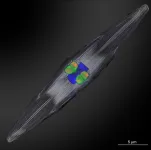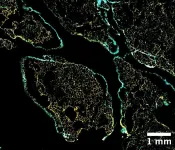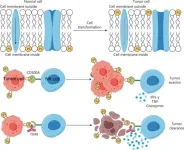(Press-News.org) New research by the University of East Anglia (UEA) reveals what countries think will be their most difficult to decarbonise sectors when they reach net zero, with agriculture expected to be responsible for the largest remaining emissions.
Once countries have taken the ‘easy’ steps to get to net zero - such as switching to more renewable electricity, electric cars, and heat pumps for homes - they are still left with some sources of emissions.
These ‘residual’ emissions continue to be emitted at the point of net zero - but their effect is cancelled out or moved elsewhere, for example by taking carbon dioxide out of the atmosphere using methods of carbon dioxide removal, or to other countries via international offsets.
Harder to decarbonise areas include aviation, agriculture, and industry, with fewer alternatives to fossil fuels. Residual emissions are expected to come from these ‘hard-to-abate’ sources, which face technical barriers to reducing them beyond a certain level.
By sector, emissions from agriculture, mainly from livestock, are anticipated to be the largest contributor - on average 36% of the total for developed countries. The findings are published today in the journal One Earth.
The team, from the Schools of Environmental Sciences, Global Development and Tyndall Centre for Climate Change Research at UEA, analysed national climate strategies for 71 countries. Only 26 quantify residual emissions, with most aiming to reach net zero by 2050.
The researchers mapped the reasons why a country claims a certain emission source is residual or otherwise hard-to-abate, finding that many see residual emissions as an inevitability, instead of a focus of further climate policy efforts, innovating further solutions or exploring other policy options, such as reducing demand.
Lead author Harry Smith, a Leverhulme Trust Doctoral Scholar at UEA, said current plans showed limited ambition in dealing with residual emissions: “Net zero targets have rapidly become the new norm of national climate policy. They imply a need to compensate for the remaining residual emissions through the deployment of carbon dioxide removal methods. Yet governments are only now exploring what this balance could or should be.
“High residual emissions, paired with greater deployment of carbon dioxide removal, may allow countries to retain or expand fossil fuel use and production. Given the limits of carbon dioxide removal, this risks the credibility of their target and may jeopardise global climate goals.
“Similarly, treating residual emissions as an inevitability, risks de-emphasising these emissions, locking-in high emitting activities and infrastructure, and locking-out other ways to reduce emissions.”
The study is the first to look in this level of detail, and for this number of net zero plans that describe what countries think will be their difficult to decarbonise sectors, and how low they aim to get their emissions before cancelling out the remainder with carbon dioxide removal.
The authors found that some countries, such as the UK and Spain, are ambitious, including scenarios that reduce their emissions by upwards of 90% compared to when their emissions started falling, leaving less than 10% of their emissions as residual and cancelled out by carbon dioxide removal.
However, others, such as Canada, are less ambitious and have drawn up scenarios that retain greater fossil fuel use and production, reducing their emissions by just over a half before cancelling out the remainder.
For developed countries, residual emissions are sizeable, on average 21% when compared to when their greenhouse gas emissions started falling. This average hides a large range, however: they could be as low as 5% or as high as 52%.
As well as making up the majority of residual emissions, agriculture represents the sector which sees the least progress between now and net zero, with a reduction of only 37% on average for the same countries. Meanwhile industrial emissions from the manufacturing of goods, emissions commonly discussed as residual and hard-to-abate, are reduced by 70% on average.
“Our study shows that countries vary greatly in how they envision what getting to net zero means for them,” said co-author Dr Naomi Vaughan. “Some use the reporting of emission and carbon removals together to hide their weaker emissions reduction ambition by betting on currently very niche carbon removal methods. We suggest that strengthening the reporting requirements would improve transparency.
“This work highlights that what emissions remain when countries aim to reach net zero should be put under more scrutiny. A better understanding is needed of which emissions are truly ‘difficult to decarbonise’ and which could be addressed through changes to demand, for example dietary changes, reducing flying, the circular economy, alongside more investment in research and innovation.”
The study examined all national climate strategies submitted to the UN Framework Convention on Climate Change before October 2023, as well as similar strategies submitted to the European Commission.
‘Residual emissions in long-term national climate strategies show limited climate ambition’, Harry Smith, Naomi Vaughan and Johanna Forster, is published in One Earth on May 9.
END
Net zero plans show limited climate ambition on ‘residual’ emissions
2024-05-09
ELSE PRESS RELEASES FROM THIS DATE:
New Rhizobia-diatom symbiosis solves long-standing marine mystery
2024-05-09
Nitrogen is an essential component of all living organisms. It is also the key element controlling the growth of crops on land, as well as the microscopic oceanic plants that produce half the oxygen on our planet. Atmospheric nitrogen gas is by far the largest pool of nitrogen, but plants cannot transform it into a usable form. Instead, crop plants like soybeans, peas and alfalfa (collectively known as legumes) have acquired Rhizobial bacterial partners that “fix” atmospheric nitrogen into ammonium. This partnership makes legumes one of the most important ...
New stem cell research may have implications for liver transplantation
2024-05-09
Liver disease, due to viral infections, alcohol abuse, obesity, or cancer, accounts for 1 in every 25 deaths worldwide. A liver transplant can be life saving for people with end-stage liver disease. However, the procedure has limitations related to donor shortage, a technically challenging and invasive surgical procedure, and the requirement for lifelong immunosuppressive medication in the transplant recipients. An alternative to whole organ transplantation is the less invasive injection of dissociated human liver cells, but donor shortage is still an issue. Utilizing ...
New cells could be key to treating obesity
2024-05-09
Understanding how fat tissue forms and functions is crucial for addressing obesity and related metabolic diseases. However, adipose tissue, or body fat, behaves differently based on its location in the body.
Take, for example, the omentum: a large, apron-like fatty tissue hanging from the stomach that covers organs within the peritoneum, such as the stomach and intestines. It not only stores fat but also plays roles in immune regulation and tissue regeneration.
Omental adipose tissue is associated with ...
Supercharging immune cells to battle blood cancer: Breakthrough in cancer immunotherapy
2024-05-09
A new study reveals a groundbreaking approach to immunotherapy, demonstrating that blocking the interaction between the CD300A receptor and phosphatidylserine (PS) significantly enhances the ability of human natural killer (NK) cells to lyse hematologic malignancies (HMs).
Cancer has a profound impact on human life, and immune checkpoint therapy (ICT) has made remarkable strides in cancer treatment. However, ICT faces challenges such as low overall response rates and the emergence of immune-related adverse events. To overcome these hurdles, researchers are exploring new immune checkpoints. CD300A, a type-I transmembrane protein with immunoreceptor tyrosine-based inhibitory ...
Liberals and conservatives differ on climate change beliefs—but are relatively united in taking action
2024-05-09
The division between liberals and conservatives on both climate-change beliefs and related policy support is long-standing. However, the results of a newly released global experiment show that despite these differences, the two camps actually align when it comes to taking certain actions to combat climate change.
The study, led by researchers at New York University, finds that when given the opportunity, liberals and conservatives take action to address climate change at roughly the same levels—and that ...
Biogeographical evidence shows trickster animal folklore limited by environmental factors
2024-05-09
Humans have the capacity to imagine civilizations and creatures that have never existed, and our language reflects that ability. It would therefore be understandable if the stories we tell ourselves stretched beyond the bounds of local ecology. However, research has shown that many cultural artifacts and ideas are strongly affected by environmental factors.
Researchers in Japan wanted to know if the biogeography of a region could constrain motifs in animal folklore. To do this, they studied the distribution of animal trickster folklore against the distribution of the animal the folklore ...
Researchers harness blurred light to 3D print high quality optical components
2024-05-09
WASHINGTON — Canadian researchers have developed a new 3D printing method called blurred tomography that can rapidly produce microlenses with commercial-level optical quality. The new method may make it easier and faster to design and fabricate a variety of optical devices.
“We purposely added optical blurring to the beams of light used for this 3D printing method to manufacture precision optical components,” said Daniel Webber from the National Research Council of Canada. “This enables production of optically smooth surfaces.”
In Optica, Optica Publishing Group’s journal for high-impact research, these researchers demonstrate the new method by using ...
Older adults with aggressive blood cancer are responsive to treatment and show prolonged survival
2024-05-09
(WASHINGTON, May 9, 2024) – Standard of care treatment for acute myeloid leukemia (AML) is safe and effective for adults over 80, according to a study published in Blood Neoplasia. For roughly a quarter of patients, this treatment can durably prolong survival.
AML is an aggressive and often deadly form of blood cancer that can be difficult to treat. For older adults with AML, the conventional treatment consists of a medication called venetoclax combined with a hypomethylating agent (HMA), also known as VEN-HMA. AML treatment is often intensive and can significantly suppress the immune system ...
Redesigning healthcare: Integrating social care into a safety net health system
2024-05-09
INDIANAPOLIS -- Neighborhoods of high need are where investment in social care offers the best opportunities to improve health. Screening for social determinants of health is comparatively easy, but building the infrastructure to meet needs occurring outside the formal healthcare system is quite difficult. Few health systems have achieved more than even partial integration of social care into routine patient care.
In a case study of pioneering social care provided by Eskenazi Health, a safety net health system located in Indianapolis, ...
Discovery made into which children will outgrow their peanut allergy
2024-05-09
Australian researchers have discovered how changes in antibody levels over time can predict which children are likely to outgrow their peanut allergy.
The research, led by Murdoch Children’s Research Institute (MCRI) in Melbourne and published in Allergy, found two thirds of children with a peanut allergy remain allergic by the age of 10. But for those who did naturally outgrow their allergy, the majority achieved this by six years old.
The study was the first to use antibodies as biomarkers to identify persistent or a resolved ...





